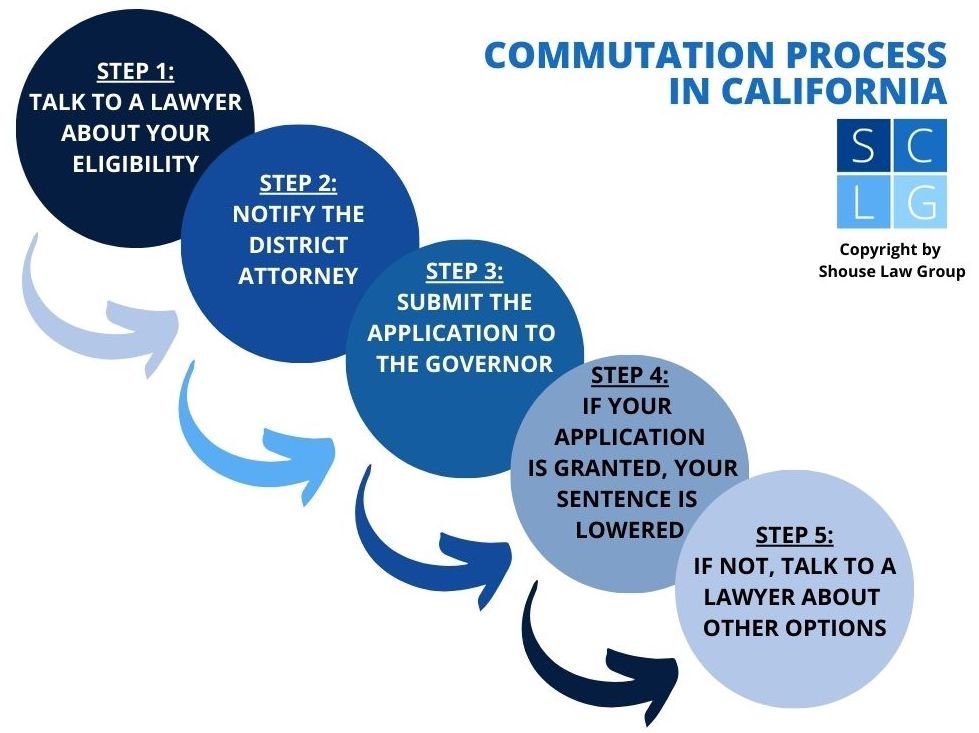
In California, a commutation is a type of executive clemency that reduces or eliminates a prisoner’s sentence. Inmates serving a jail or prison sentence can petition the California governor to commute their sentence.
A governor’s commutation can also make a prisoner immediately eligible for parole. California’s Board of Parole Hearings will then determine whether the prisoner is ready for release.
The following flowchart summarizes the commutation of sentence process in California:

To help you better understand how to get a commutation of sentence in California, our Los Angeles criminal defense lawyers discuss:
- 1. What is a commutation?
- 2. Who is eligible?
- 3. How the Governor Decides
- 4. How to Apply
- 5. What happens next?
- 6. When Applicants Are Victims
- 7. Costs
- 8. Odds of Success
- 9. How Long it Takes
- 10. After Commutation Is Granted
- 11. Real-World Examples
- Additional Reading

An inmate’s age and conduct while in prison are factors that can help California’s governor decide whether to grant a commutation (executive clemency).
1. What is a commutation?
A commutation is a reduction or elimination of a prisoner’s sentence in California. It does not:
- Reverse a finding of guilt or
- Restore civil rights lost as the result of a conviction.1
Instead, civil rights can be restored in California by a:
Benefits of a Commutation
Even though a commutation does not restore civil rights, it can:
- Reduce a sentence (sometimes allowing the inmate to be released immediately),
- Secure a parole hearing before the inmate would otherwise be eligible, or
- Convert a death sentence to a life sentence.2
It can also reduce or eliminate a fine or another court-ordered penalty.3
2. Who is eligible?
Anyone convicted of a California criminal offense can have a sentence commuted by the governor (except people who were impeached). 4
Even people sentenced to death or life imprisonment can have their sentences commuted by the governor.
However, the California’s governor cannot commute a sentence if the conviction was for:
- An offense under the criminal laws of another state or country,
- A violation of United States (federal) law, or
- A military offense.
3. How the Governor Decides
There are no set factors required for commuting a sentence in California. The state constitution confers absolute authority on the governor to grant one.
The only limitation is that people convicted of at least two felonies cannot be commuted without the approval of a majority of the California Supreme Court.5
Factors the governor will often consider include:
- The severity of the prisoner’s criminal conviction(s),
- Harm to victims,
- The prisoner’s age at the time of the crime(s),
- The prisoner’s age at the time of application for commutation,
- The number of years the prisoner has served,
- The prisoner’s conduct while in jail or prison,
- Education obtained while incarcerated,
- Evidence of remorse for the crime(s),
- Evidence of victim restitution or attempts to make things right,
- Public opinion,
- The opinion of victims and/or the District Attorney,
- Whether the prisoner was subject to “intimate partner battering” (as discussed in Section 5, below),
- Whether the applicant poses a threat to the community,
- Whether the prisoner will have a job and housing upon release, and
- Any other factors that might be relevant, such as criminal history.6

Inmates who get an education while in prison often have an easier time getting their sentences commuted in California
4. How to Apply
To obtain a commutation, an applicant must:
- Notify the district attorney of the county or counties where the applicant was convicted;7 and
- Complete and mail a notarized commutation application to the governor.
Both forms can be downloaded from the Application for Executive Clemency on the California governor’s website.
Let’s take a closer look at each of these steps.
Notifying the District Attorney
Before applying for commutation, the applicant must serve a notice of intent to apply for clemency to the district attorney. The notice should be sent to the D.A. of each county in which the applicant was convicted.
A form for this notice is provided along with the downloadable Application for Executive Clemency. This form must be used since it contains a field for the D.A. to acknowledge receipt of the notice.
When Notice Must be Sent
The notice must be sent to the district attorney before submitting the Application for Executive Clemency to the governor.
The applicant will need to swear – by a signed, notarized affidavit – that the D.A. was so notified. This affidavit must be submitted to the governor along with the application for commutation.
The affidavit must be signed in front of a notary. A list of notaries can be found on the notary public listing on the California Secretary of State’s webpage.
The D.A. will return the acknowledgment of receipt directly to the governor’s office.
How Much Notice the D.A. Requires
The D.A. must receive at least 10 days’ notice before the governor can act upon an application for executive clemency.8
An exception is if:
- There is imminent danger of the death of the person convicted or imprisoned, or
- The inmate’s term of imprisonment is within 10 days of its expiration.9
Although it is not necessary, we recommend sending the notice by certified mail or another method that provides proof of receipt.
What does the D.A. Do next?
The district attorney may submit a written recommendation to the governor for or against commutation of sentence.10
The D.A. will also make reasonable efforts to notify the victim(s) of the crime related to the application. Such victim(s) and/or their families may also submit a recommendation to the governor.11
Applying for Executive Clemency
The application for commutation is not complicated. However, the applicant will need to provide:
- A list of all conviction(s) and circumstances,
- The reason the applicant is seeking a commutation,
- A statement of why the applicant believes a commutation should be granted, and
- A full statement of any compensation paid to any person for assisting with getting a commutation.
Application Must be Notarized
The application must be notarized. It should then be sent via regular or certified mail to:
Governor’s Office
Attn: Legal Affairs
State Capitol
Sacramento, CA 95814
The application can be notarized at the same time as the affidavit of notice to the D.A.
5. What happens next?
The governor is not required to grant, or even to consider, an application for a commuted sentence.
If the governor decides to act, they will usually refer the application to the Board of Parole Hearings.
The Board will then conduct an investigation and recommend to the governor whether the request should be granted.12
What the Board of Parole Does
During its investigation, the Board may take testimony and examine witnesses under oath. 13
It may also review a summarized statement of the facts of the inmate’s case. This statement will be provided by the court in which the inmate was convicted. 14
The governor may also submit the application to law enforcement or other agencies for investigation or recommendation.
Note that the governor is not obligated to seek the review of the Parole Board or any other agency.
Parole Board Public Meetings
If the governor requests a review, the Parole Board will conduct an investigation. When the investigation is complete, the case will be presented to the Executive Board at a public meeting.
The applicant will be notified of when the Board will be considering their case. They will be offered the opportunity to provide additional information (though they will not attend the meeting).
Members of the public (such as victims and their families) will have the opportunity to speak for up to five (5) minutes each.15
After the meeting, the Board will send its investigation report and recommendation to the Governor. The Board will also notify the applicant of the result of the meeting.
Referral to the California Supreme Court
If the applicant has two or more felony convictions, the governor may not commute a sentence without the consent of at least four of the justices of the California Supreme Court.16 Thus if the governor is inclined to grant the application in such a case, they must refer the application to the court.
However, the governor is not obligated to seek the court’s consent if the governor wants to ignore or decline the application.
If referred to the court, the governor’s application for a recommendation is treated as a court proceeding. The Chief Justice will notify the governor in writing of the court’s recommendation.
6. When Applicants Are Victims
California law allows the Parole Board to consider whether an inmate was subject to “intimate partner battering and its effects.” Specifically, the Board would take into account:
“evidence of the nature and effects of physical, emotional, or mental abuse upon the beliefs, perceptions, or behavior of victims of domestic violence if it appears the criminal behavior was the result of that victimization.”17
An “intimate partner” is the applicant’s current or former:
- Spouse,
- Registered domestic partner,
- Cohabitant (live-in partner),
- Fiancé(e)
- Boyfriend/girlfriend, or
- Co-parent.18
In these cases, the applicant is usually a victim of either:

Inmates who were victims of “intimate partner battering” may be able to get clemency from California’s governor.
7. Costs
There is no fee to apply for commutation of a sentence in California.
There may be attorney’s fees if the applicant hires a lawyer to assist with getting a commutation.
8. Odds of Success
The commutation of a California sentence is a rare form of clemency.19 It is usually granted only where it is apparent that the sentence was too harsh, typically because of:
- The prisoner’s young age at the time the offense was committed,
- Evidence of intimate partner battering or other abuse, or
- Laws that were too harsh at the time of sentencing.
9. How Long it Takes
Since there is no requirement that a governor even considers an application for clemency, it is impossible to estimate how long the process will take. It could be months or longer.
10. After Commutation Is Granted
If an application for commutation is granted, the prison and/or parole board, as applicable, will begin implementing the new sentence.
The application and disposition will be filed with the California Secretary of State and reported to the California Legislature. They then become a matter of public record, though certain details (such as a new address) will be redacted before the information is made public.20
The governor’s office will notify the California Department of Justice that the inmate’s sentence has been commuted. The DOJ will then notify the Federal Bureau of Investigation.
These agencies will update their records to show that the sentence for the conviction has been commuted.
11. Real-World Examples
Here are some examples of commutations approved by Governor Jerry Brown in 2017:21
Second-Degree Murder – Eligible for Parole
An 18-year old was convicted of second-degree murder (Penal Code 187) after his accomplice killed someone during an armed robbery.
While behind bars, the prisoner earned a high school diploma and trained to be a paralegal. Former Los Angeles Mayor Richard Riordan then offered him a job and housing and the governor made him eligible for parole.
Life Sentence for Murder – Eligible for Parole
A woman was convicted of murder and sentenced to 25 years to life after her abusive pimp robbed a man and stabbed him to death in a motel room.
While in prison, the woman helped care for terminally ill inmates. She was made eligible for parole early due to her “limited role” in the murder, her past abuse and her work inside prison.
Attempted Murder – Sentenced Reduced
A 17-year-old was sentenced to 22 years in prison for attempted murder after he shot a man at a nightclub.
While in prison, he dropped out of his gang. He earned a high school diploma and three associate degrees. He participated in numerous prison programs and became a literacy tutor.
The governor reduced his sentence to nine (9) years.
First-Degree Murder – Eligible for Parole
A woman and her boyfriend kidnapped and robbed a shopper. The boyfriend then fatally shot the victim.
The woman was sentenced to life without the possibility of parole for first-degree murder.
While she was in prison, 7,000 people signed a petition supporting her release. She had a job and housing waiting. The governor made her eligible for parole.
Additional Reading
For more information on commutations, refer to these scholarly articles:
- Faith in Fantasy: The Supreme Court’s Reliance on Commutation to Ensure Justice in Death Penalty Cases – Vanderbilt Law Review.
- Getting off Death Row: Commuted Sentences and the Deterrent Effect of Capital Punishment – The Journal of Law and Economics.
- Commutation of Prison Sentences: Practice, Promise, and Limitation – Crime & Delinquency.
- Consistency and Compensation in Mercy: Commutation in the Era of Mass Incarceration – Social Forces.
- Institutional Disparities: Considerations of Gender in the Commutation Process for Incarcerated Women – Signs: Journal of Women in Culture and Society.
Also see our article on pardon applications in California.
Legal References:
- See for example, KPCC, Gov. Brown commutes 9 lengthy prison sentences, August 18, 2017.
- California Constitution Article V, Section 8(a): “Subject to application procedures provided by statute, the Governor, on conditions the Governor deems proper, may grant a reprieve, pardon, and commutation, after sentence, except in case of impeachment. The Governor shall report to the Legislature each reprieve, pardon, and commutation granted, stating the pertinent facts and the reasons for granting it. The Governor may not grant a pardon or commutation to a person twice convicted of a felony except on recommendation of the Supreme Court, 4 judges concurring.” See also Santos v. Brown (Cal. App. 3d Dist., 2015), 238 Cal. App. 4th 398.
- See also California Penal Code 4802: “In the case of a person twice convicted of felony, the application for pardon or commutation of sentence shall be made directly to the Governor, who shall transmit all papers and documents relied upon in support of and in opposition to the application to the Board of Parole Hearings.”
- California Constitution Article V, Section 8(a): “Subject to application procedures provided by statute, the Governor, on conditions the Governor deems proper, may grant a reprieve, pardon, and commutation, after sentence, except in case of impeachment. The Governor shall report to the Legislature each reprieve, pardon, and commutation granted, stating the pertinent facts and the reasons for granting it. The Governor may not grant a pardon or commutation to a person twice convicted of a felony except on recommendation of the Supreme Court, 4 judges concurring.” See also Santos v. Brown (Cal. App. 3d Dist., 2015), 238 Cal. App. 4th 398.
- Same. See also Penal Code 4800 PC: “The general authority to grant reprieves, pardons and commutations of sentence is conferred upon the Governor by Section 8 of Article V of the Constitution of the State of California.”
- See, for example, Governor Brown Grants Executive Clemency (list of pardons and commutations granted by Governor Jerry Brown in December 2017). See also Penal Code 4801(a) and (b):“(a) The Board of Parole Hearings may report to the Governor, from time to time, the names of any and all persons imprisoned in any state prison who, in its judgment, ought to have a commutation of sentence or be pardoned and set at liberty on account of good conduct, or unusual term of sentence, or any other cause, including evidence of intimate partner battering and its effects. For purposes of this section, “intimate partner battering and its effects” may include evidence of the nature and effects of physical, emotional, or mental abuse upon the beliefs, perceptions, or behavior of victims of domestic violence if it appears the criminal behavior was the result of that victimization. (b) (1) The board, in reviewing a prisoner’s suitability for parole pursuant to Section 3041.5, shall give great weight to any information or evidence that, at the time of the commission of the crime, the prisoner had experienced intimate partner battering, but was convicted of an offense that occurred prior to August 29, 1996. The board shall state on the record the information or evidence that it considered pursuant to this subdivision, and the reasons for the parole decision. The board shall annually report to the Legislature and the Governor on the cases the board considered pursuant to this subdivision during the previous year, including the board’s decisions and the specific and detailed findings of its investigations of these cases.”
- Penal Code 4805:“(a) At least 10 days before the Governor acts upon an application for a commutation of sentence, written notice of the intention to apply therefor, signed by the person applying, shall be served upon the district attorney of the county where the conviction was had, and proof, by affidavit, of the service shall be presented to the Governor. (b) The district attorney may submit a written recommendation to the Governor for or against commutation of sentence. (c) The district attorney shall make reasonable efforts to notify the victim or victims of the crime or crimes related to the application and the victims’ families who may also submit a recommendation to the Governor for or against commutation of sentence.
- Penal Code 4805(a).
- Penal Code 4806. “The provisions of Sections 4804 and 4805 are not applicable:(a) When there is imminent danger of the death of the person convicted or imprisoned. (b) When the term of imprisonment of the applicant is within 10 days of its expiration.
- Penal Code 4805(b).
- Penal Code 4805(c).
- Penal Code 4812: “Upon request of the Governor, the Board of Parole Hearings shall investigate and report on all applications for reprieves, pardons, and commutation of sentence and shall make such recommendations to the Governor with reference thereto as to it may seem advisable. To that end the board shall examine and consider all applications so referred and all transcripts of judicial proceedings and all affidavits or other documents submitted in connection therewith, and shall have power to employ assistants and take testimony and to examine witnesses under oath and to do any and all things necessary to make a full and complete investigation of and concerning all applications referred to it. Members of the board and its administrative officer are, and each of them is, hereby authorized to administer oaths.”See also Penal Code 4813: “In the case of applications of persons twice convicted of a felony, the Board of Parole Hearings, after investigation, shall transmit its written recommendation upon such application to the Governor, together with all papers filed in connection with the application.”
- Same.
- Penal Code 4803: “When an application is made to the Governor for pardon or commutation of sentence, or when an application has been referred to the Board of Parole Hearings, the Governor or the board may require the judge of the court before which the conviction was had, or the district attorney by whom the action was prosecuted, to furnish the Governor or the board, without delay, with a summarized statement of the facts proved on the trial, and of any other facts having reference to the propriety of granting or refusing said application, together with his or her recommendation for or against the granting of the same and his or her reason for such recommendation.”
- See, for example, agenda for March 20, 2018 meeting of the Parole Board.
- See endnotes 2 and 3.
- Penal Code 4801(a) and (b).
- See, for example, Penal Code 273.5(b).
- See for example, KPCC, Gov. Brown commutes 9 lengthy prison sentences, August 18, 2017.
- Penal Code 4807:“(a) At the beginning of every regular session of the Legislature, the Governor shall file a written report with the Legislature that shall include each application that was granted for each case of reprieve, pardon, or commutation by the Governor, or his or her predecessor in office, during the immediately preceding regular session of the Legislature, stating the name of the person convicted, the crime of which the person was convicted, the sentence and its date, the date of the reprieve, pardon, or commutation, and the reason for granting the same. The report shall be submitted in compliance with Section 9795 of the Government Code. (b) Notwithstanding any other law, the written report filed with the Legislature pursuant to subdivision (a) shall be available to the public.”
- See for example, KPCC, Gov. Brown commutes 9 lengthy prison sentences, August 18, 2017. See also People v. Bramit (Cal., 2009), 46 Cal. 4th 1221. See also People v. Guerra (Cal., 2006), 37 Cal. 4th 1067.
